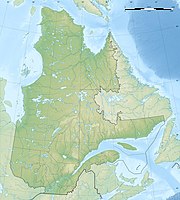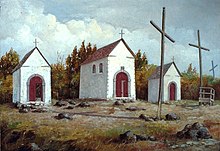Parc national d'Oka
|
Parc national d'Oka
|
||
|
Welcome to the Parc national d'Oka |
||
| location | Quebec , Canada | |
| surface | 23.7 km² | |
| WDPA ID | 66609 | |
| Geographical location | 45 ° 28 ' N , 74 ° 2' W | |
|
|
||
| Setup date | 1990 | |
| administration | Parcs Québec, SEPAQ | |
The Parc national d'Oka is one of the current 27 national parks in the Canadian province of Québec . There, a corresponding Parc national but what in the other provinces and territories a provincial park ( Provincial Park is). The park is operated by Sépaq ( French Société des établissements de plein air du Québec or English Society of outdoor recreation establishments of Quebec ).
The 23.7 km² park in the extreme south of the province was established in 1990. Its task is to preserve or regenerate a type of forest that has become rare in Canada. The park borders on the Lac des Deux Montagnes , a widening of the Ottawa River , for more than 7 km . It is located between the village of Oka and the city of Pointe-Calumet .
history
Artifacts document a 4,500-year Native American presence in what is now the park. In 1717 the governor of New France transferred the area on Lac des Deux Montagnes to the Sulpizians . In 1962, the Québec government acquired 1.6 km² of land from the Sulpizians and set up the Réserve de chasse et de pêche de Deux Montagnes ( Deux Montagnes fishing and hunting reserve), which was in Parc provincial d'Oka in 1963 and in Parc Paul-Sauvé in 1968 was renamed. The infrastructure (campsite, beach, roads and sewage treatment plant) were built for Expo 67 . In 1974 the government expanded the area to 23.7 km² and classified the Calvaire d'Oka in it as a historic district .
In 1990 the park received its current status as a recreation area (parc de récréation). The park, managed by the Société des établissements de plein air du Québec (Sépaq), has been called the Parc national d'Oka since 2001 .
Flora and fauna
Migratory birds visit the area in large numbers (including great blue herons ), and wood ducks also breed there . There are also fish, turtles, snakes and small mammals, but also white-tailed deer . Their number and distribution was only examined from 2010 onwards. Local trees include sugar maple , red oak and white pine .
In 2005, the area around the park was still largely used for agriculture or forestry, only 0.1% of the areas there were able to recover from economic use. Also within the park area, fragmentation and species depletion make it difficult to maintain biodiversity, as does the fact that around a third of the species were not originally represented here.
Calvary
The calvary located in the park originally served the missionary mission of the regional indigenous population . The seven stations of the cross were built between 1740 and 1742 by the Sulpizians with the help of the Mohawks . The Calvaire d'Oka was one of the most visited pilgrimage sites in the province of Québec from the end of the 19th century until the 1950s.
See also
literature
- Parcs Québec and Sépaq (eds.), La recherche scientifique dans les Parcs nationaux québécois. Priorités et potentiels de recherche , undated , pp. 139–145.
- John R. Porter and Jean Trudel, Le calvaire d'Oka , Ottawa: Galerie nationale du Canada, 1974.
Web links
- Parc national d'Oka , Sépaq (French)
Individual evidence
- ↑ Sépaq (ed.), Oka National Park. Guide du visiteur - 2015 at: sepaq.com, accessed on August 17, 2015 (pdf, French).
- ↑ a b c Portrait du parc at: sepaq.com, accessed on August 17, 2015 (French).
- ↑ a b c d Gilles Piédalue, Colline du Calvaire d'Oka at: ameriquefrancaise.org, accessed on August 17, 2015 (French, English ).
- ^ A. Sabourin: Flore vasculaire et principaux groupements végétaux du parc national d'Oka , Parc national d'Oka 2009.


